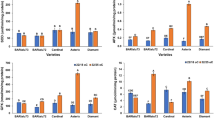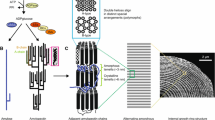Abstract
Leaf senescence is characterized by nitrogen remobilization to developing seeds of annual plants, or surviving organs of perennial species. It has been demonstrated that high carbohydrate levels (carbon “feast”) are associated with the onset of the senescence process. Therefore, the development of model systems allowing the manipulation of leaf carbohydrates constitutes a logical first step in the investigation of processes important during early phases of senescence, such as plastidial protein degradation. In this study, sugar accumulation was induced either by the incubation of excised, mature barley (Hordeum vulgare L.) leaves under relatively strong light, or by the interruption of sieve tubes at the base of the leaf lamina by “steam-girdling”. Accelerated chlorophyll degradation and net proteolysis confirmed successful senescence induction in both model systems, but suggested that girdled leaves are more useful than excised leaves to study proteolysis. Activities or transcript levels of several proteolytic enzymes, including plastidial (aminopeptidases, Clp protease), cytosolic (proteasome) and vacuolar (thiol proteases, an aspartic protease and a serine carboxypeptidase) proteases were clearly induced under these conditions; some of these genes also reacted to other stimuli such as leaf excision. The most interesting finding was the specific induction of a carboxypeptidase gene (cp-mIII) in girdled leaves accumulating high carbohydrate levels. As a previous study from our laboratory, using a genetic approach, has indicated that one or several carboxypeptidases are involved in leaf N remobilization, the detailed characterization of cp-mIII (and, possibly, closely related genes) may considerably improve our understanding of whole-plant N recycling.






Similar content being viewed by others
Notes
The ATP binding subunit of the Clp protease has been designated ClpA in E. coli, and ClpC in plants. See Adam et al. (2001) for a recent review
References
Adam Z, Adamska I, Nakabayashi K, Ostersetzer O, Haussuhl K, Manuell A, Zheng B, Vallon O, Rodermel SR, Shinozaki K, Clarke AK (2001) Chloroplast and mitochondrial proteases in Arabidopsis. A proposed nomenclature. Plant Physiol 125:1912–1918
Beers EP, Jones AM, Dickerman AW (2004) The S8 serine, C1A cysteine and A1 aspartic protease families in Arabidopsis. Phytochemistry 65:43–58
Brouquisse R, James F, Pradet A, Raymond P (1992) Asparagine metabolism and nitrogen distribution during protein degradation in sugar-starved maize root tips. Planta 188: 384–395
Brouquisse R, Masclaux C, Feller U, Raymond P (2001) Protein hydrolysis and nitrogen remobilization in the plant life and senescence. In: Lea PJ, Morot-Gaudry J-F (eds) Plant nitrogen. Springer, Berlin Heidelberg New York, pp. 275–293
Buchanan-Wollaston V (1997) The molecular biology of leaf senescence. J Exp Bot 48:181–199
Chevalier C, Bourgeois E, Pradet A, Raymond P (1995) Molecular cloning and characterization of six cDNAs expressed during glucose starvation in excised maize (Zea mays L.) root tips. Plant Mol Biol 28:473–485
Crafts-Brandner SJ, Below FE, Harper JE, Hageman RH (1984a) Differential senescence of maize hybrids following ear removal. I. Whole plant. Plant Physiol 74:360–367
Crafts-Brandner SJ, Below FE, Wittenbach VA, Harper JE, Hageman RH (1984b) Differential senescence of maize hybrids following ear removal. II. Selected leaf. Plant Physiol 74:368–373
Dai N, Schaffer A, Petreikov M, Shahak Y, Giller Y, Ratner K, Levine A, Granot D (1999) Overexpression of Arabidopsis hexokinase in tomato plants inhibits growth, reduces photosynthesis, and induces rapid senescence. Plant Cell 11:1253–1266
Feller U, Fischer A (1994) Nitrogen metabolism in senescing leaves. Crit Rev Plant Sci 13:241–273
Feller UK, Soong TS-T, Hageman RH (1977). Leaf proteolytic activities and senescence during grain development of field-grown corn (Zea mays L.). Plant Physiol 59: 290–294
Fischer A, Brouquisse R, Raymond P (1998) Influence of senescence and carbohydrate levels on the pattern of leaf proteases in purple nutsedge (Cyperus rotundus). Physiol Plant 102:385–395
Fröhlich V, Feller U (1992) Effect of phloem interruption on endopeptidase and aminopeptidase activities in flag leaves of field-grown wheat. Biochem Physiol Pflanzen 188:13–21
Gut H, Matile P (1988a) Breakdown of galactolipids in senescent barley leaves. Bot Acta 102:31–36
Gut H, Matile P (1988b) Apparent induction of key enzymes of the glyoxylic acid cycle in senescent barley leaves. Planta 176:548–550
Holwerda BC, Rogers JC (1992) Purification and characterization of aleurain. A plant thiol protease functionally homologous to mammalian cathepsin H. Plant Physiol 99:848–855
Hörtensteiner S, Feller U (2002) Nitrogen metabolism and remobilization during senescence. J Exp Bot 53:927–937
Jongebloed U, Szederkényi J, Hartig K, Schobert C, Komor E (2004) Sequence of morphological and physiological events during natural ageing and senescence of castor bean leaf: sieve tube occlusion and carbohydrate back-up precede chlorophyll degradation. Physiol Plant 120:338–346
Kleber-Janke T, Krupinska K (1997) Isolation of cDNA clones for genes showing enhanced expression in barley leaves during dark-induced senescence as well as during senescence under field conditions. Planta 203:332–340
Koch KE (1996) Carbohydrate-modulated gene expression in plants. Annu Rev Plant Physiol Plant Mol Biol 47:509–540
Koroleva O, Farrar JF, Tomos AD, Pollock CJ (1998) Carbohydrates in individual cells of epidermis, mesophyll, and bundle sheath in barley leaves with changed export or photosynthetic rate. Plant Physiol 118:1525–1532
Krapp A, Quick WP, Stitt M (1991) Ribulose-1,5-bisphosphate carboxylase-oxygenase, other Calvin-cycle enzymes, and chlorophyll decrease when glucose is supplied to mature spinach leaves via the transpiration stream. Planta 186:58–69
Laemmli UK (1970) Cleavage of structural proteins during the assembly of the head of bacteriophage T4. Nature 227:680–685
Masclaux C, Valadier M-H, Brugière N, Morot-Gaudry J-F, Hirel B (2000) Characterization of the sink/source transition in tobacco (Nicotiana tabacum L.) shoots in relation to nitrogen management and leaf senescence. Planta 211:510–518
McCarty DR (1986) A simple method for extraction of RNA from maize tissue. Maize Genet Coop Newsl 60:61
Mitsuhashi W, Crafts-Brandner S J, Feller U (1992) Ribulose-1, 5-bis-phosphate carboxylase/oxygenase degradation in isolated pea chloroplasts incubated in the light or in the dark. J Plant Physiol 139:653–658
Moore B, Zhou L, Rolland F, Hall Q, Cheng W-H, Liu Y-X, Hwang I, Jones T, Sheen J (2003) Role of the Arabidopsis glucose sensor HXK1 in nutrient, light, and hormonal signaling. Science 300:332–336
Noodén LD, Guiamét JJ, John I (2004) Whole plant senescence. In: Noodén LD (eds) Plant cell death processes. Academic, San Diego, pp. 227–244
Peoples MB, Dalling MJ (1988) The interplay between proteolysis and amino acid metabolism during senescence and nitrogen reallocation. In: Noodén LD, Leopold AC (eds) Senescence and aging in plants. Academic, San Diego, pp. 181–217
Pourtau N, Marès M, Purdy S, Quentin N, Ruël A, Wingler A (2004) Interactions of abscisic acid and sugar signalling in the regulation of leaf senescence. Planta 219:765–772
Prober JM, Trainor GL, Dam RJ, Hobbs FW, Robertson CW, Zagursky RJ, Cocuzza AJ, Jensen MA, Baumeister K (1987) A system for rapid DNA sequencing with fluorescent chain-terminating dideoxynucleotides. Science 238:336–341
Scharrenberg C, Falk J, Quast S, Hussühl K, Humbeck K, Krupinska K (2003) Isolation of senescence-related cDNAs from flag leaves of field grown barley plants. Physiol Plant 118:278–288
Smalle J, Vierstra RD (2004) The ubiquitin 26S proteasome proteolytic pathway. Annu Rev Plant Biol 55:555–590
Smidansky ED, Martin JM, Hannah LC, Fischer AM, Giroux MJ (2003) Seed yield and plant biomass increases in rice are conferred by deregulation of endosperm ADP-glucose pyrophosphorylase. Planta 216:656–664
Weaver LM, Amasino RM (2001) Senescence is induced in individually darkened Arabidopsis leaves, but inhibited in whole darkened plants. Plant Physiol 127:876–886
Woo HR, Lim PO, Nam HG, Noodén LD (2004) Genes that alter senescence. In: Noodén LD (eds) Plant cell death processes. Academic, San Diego, pp. 73–90
Yang L, Mickelson S, See D, Blake TK, Fischer AM (2004) Genetic analysis of the function of major leaf proteases in barley (Hordeum vulgare L.) nitrogen remobilization. J Exp Bot 55:2607–2616
Yoshida S (2003) Molecular regulation of leaf senescence. Curr Opin Plant Biol 6:79–84
Acknowledgements
Work presented in this study has been supported by award number 0101019 from the USDA-NRI Competitive Grants Program, and by grant agreement #04–10 from the Montana Board of Research and Commercialization Technology to A.M.F.
Author information
Authors and Affiliations
Corresponding author
Rights and permissions
About this article
Cite this article
Parrott, D., Yang, L., Shama, L. et al. Senescence is accelerated, and several proteases are induced by carbon “feast” conditions in barley (Hordeum vulgare L.) leaves. Planta 222, 989–1000 (2005). https://doi.org/10.1007/s00425-005-0042-x
Received:
Accepted:
Published:
Issue Date:
DOI: https://doi.org/10.1007/s00425-005-0042-x




